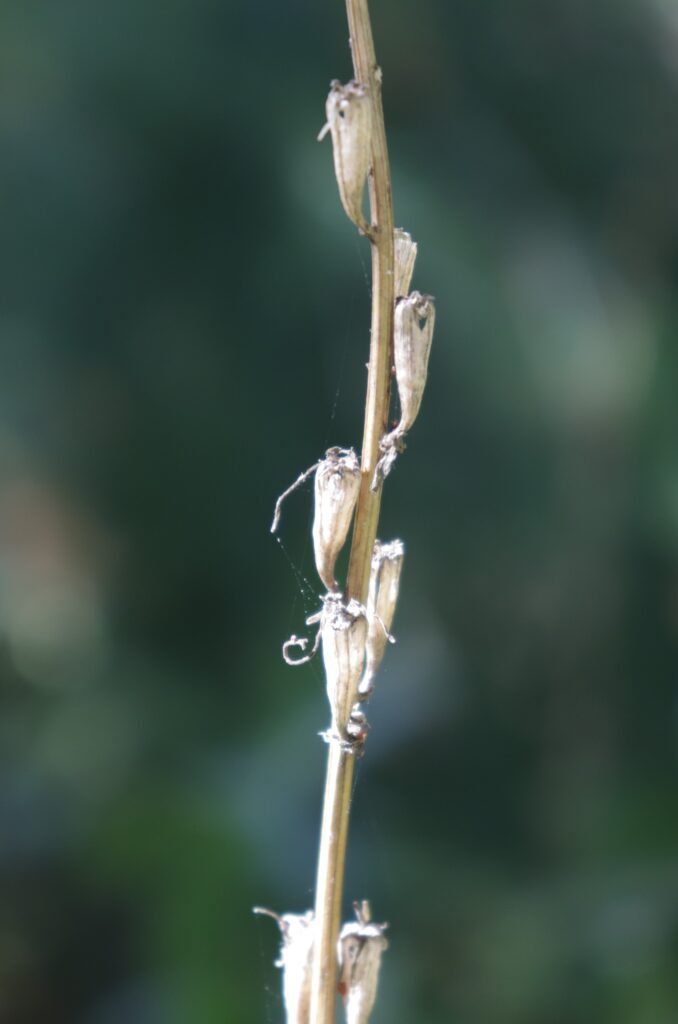Common Name: Tall Bellflower
I’ve long admired these growing in an old-growth forest bottomland near me, but only recently found them at a native plant nursery. I think they are far nicer than the invasive Creeping Bellflower, and wish they were more commonly available in garden centers. (As usual, the Plant Description and In The Garden sections are written by Shaun Booth, formerly from In Our Nature)

Scientific Name: Campanulastrum americanum
Family: Campanulaceae (Bellflower Family)
Alternate Common Names: American Bellflower
Plant description: Tall Bellflower features erect, hairy, mostly unbranching stems with slight grooves along them. The leaves are found in an alternate pattern and measure about 7.6cm – 15cm long and 1.2cm – 5cm across, becoming smaller as they ascend the stem. They are lance to egg shaped, taper to a sharp tip, hairy along major veins on the underside with a rough upper surface and have serrated margins. The leaf base narrows to hairy leaf stalks. Stems terminate with a flowers spike measuring 15cm to 60cm long with shorter flower spikes emerging from leaf axils (where the leaf meets the stem). Individual flowers are 2.5cm across with 5 blue petals and a creamy white center ring. The petals have wavy edges and pointed tips. Each flower has a style (reproductive organ) protruding from the center of the flower. Flowers give way to three sectioned seed capsules up to 1.2cm long that release numerous tiny brown seeds when mature.



Not to be confused with the common exotic garden weed, Creeping Bellflower (Campanula rapunculoide) which has more bell-shaped flowers compared to the saucer shaped flowers of Tall Bellflower. Creeping bellflower is also much shorter and more aggressive.

In the Garden: Tall Bellflower adds a strong vertical presence to gardens with delightful spires of violet-blue, star-shaped flowers. If its seeds are started in fall, then it acts as an annual. If its seeds are started in spring then it acts as a biennial. Due to its short-lived nature, it will persist in your garden via self-seeding.
Skill level: beginner
Lifespan: annual/biennial
Exposure: sun to light shade
Soil Type: rich loam, clay, sand, circumneutral (pH 6.8-7.2)
Moisture: moist to medium (plants need regular and even moisture)
Height: 150-200 cm
Spread: 30-60 cm
Bloom Period: Jun, Jul, Aug
Colour: blue
Fragrant (Y/N): N
Showy Fruit (Y/N): N
Cut Flower (Y/N): Y
Pests: no serious insect or disease problems though slugs and snails are occasional visitors, and watch for aphids
Natural Habitat: marshy ground, stream banks, openings in deciduous forests, and in disturbed areas such as trails, edges of fields and along railroads
Wildlife Value: A number of bees, including bumblebees and leaf cutting bees, butterflies and skippers, seek nectar and or pollen, and deer occasionally eat the flowers and foliage
Butterfly & Moth Larva Host Plant For: none
USDA Hardiness Zone: 4-7
Propagation: [NT, L] No treatment needed as seeds germinate easily, but they require light to break dormancy, so do not cover the seeds.


Additional Info: Deadhead spent flowers to encourage additional bloom. Plants are annual or biennial but will easily remain in a garden by self-seeding. Tall bellflower is listed as Endangered in New York State.
Native Range:
